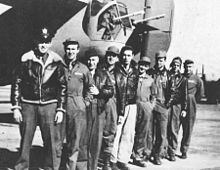
Back Lady Be Good (B-24) Spanish Lady Be Good (avion) French Lady Be Good HE Lady Be Good (aereo) Italian レディ・ビー・グッド (航空機) Japanese Lady Be Good (самолёт) Russian 善良女士號轟炸機 Chinese
This article needs additional citations for verification. (January 2024) |
 Parts were strewn by the Consolidated B-24D Liberator Lady Be Good as it skidded to a halt amid the otherwise empty Libyan desert. Engines 1, 2 and 3 visible in the photograph had their propellers feathered. | |
| Accident | |
|---|---|
| Date | April 4, 1943 |
| Summary | Navigation error, fuel exhaustion |
| Site | Kufra District, Libya 26°42′45.7″N 24°01′27″E / 26.712694°N 24.02417°E |
| Aircraft | |
| Aircraft type | B-24D Liberator |
| Operator | United States Army Air Forces |
| Flight origin | Soluch Airfield |
| Destination | Soluch Airfield or Malta |
| Crew | 9 |
| Fatalities | 9 (1 initially, 8 subsequently) |

Lady Be Good is a B-24D Liberator bomber that disappeared without a trace on its first combat mission during World War II. The plane, which was from 376th Bomb Group of the United States Army Air Forces (USAAF), was believed to have been lost—with its nine-man crew—in the Mediterranean Sea while returning to its base in Libya following a bombing raid on Naples on April 4, 1943. However, the wreck was accidentally discovered 710 km (440 mi) inland in the Libyan Desert by an oil exploration team from British Petroleum on November 9, 1958. A ground party in March 1959 later identified the aircraft as a B-24D.[1]
Investigations concluded that the first-time (all new) crew failed to realize they had overflown their air base in a sandstorm. After continuing to fly south into the desert for many hours, the crew bailed out when the plane's fuel was exhausted. The survivors then died in the desert trying to walk to safety. All but one of the crew's remains were recovered between February and August 1960. Parts from Lady Be Good were salvaged for use in other aircraft following its rediscovery, while the majority of the wreckage of the aircraft was taken to a Libyan Air Force base for safekeeping after being removed from the crash site in August 1994.
- ^ ""Lady Be Good"". National Museum of the United States Air Force™. Retrieved 2024-01-10.
